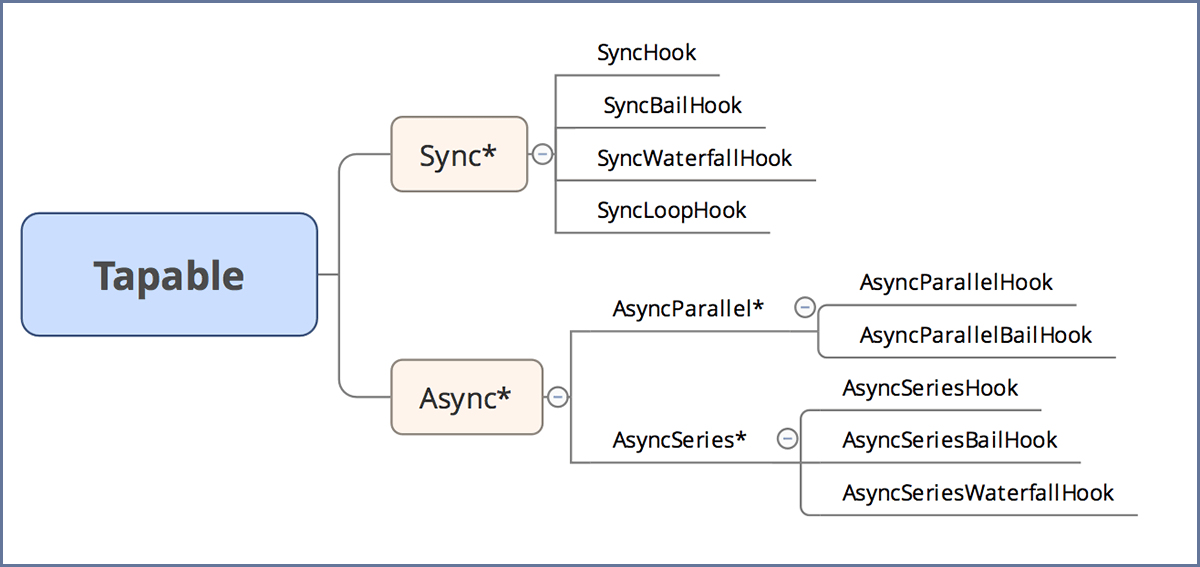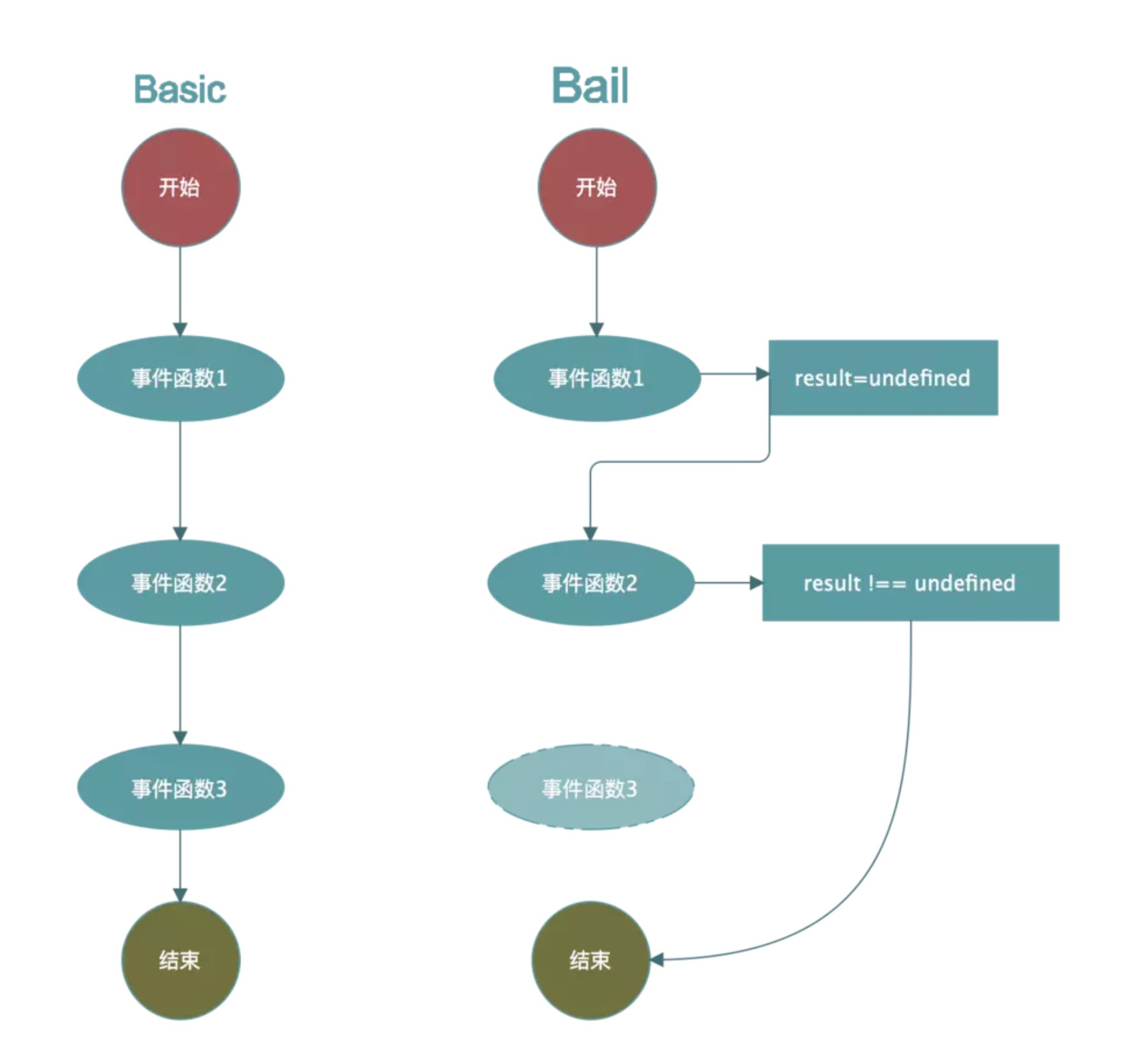tapable
Tapable
Webpack 本质上是一种事件流的机制,它的工作流程就是将各个插件串联起来,而实现这一切的核心就是 tapable,Webpack 中最核心的,负责编译的 Compiler 和负责创建 bundles 的 Compilation 都是 tapable 构造函数的实例。
了解 tapable,也可以先看 tapable-0.2 版本了解下,整个源码只有400行,相对容易理解。
也可以直接看最新版,结合示例演示,操作模拟一遍实现更直观
The tapable package expose many Hook classes, which can be used to create hooks for plugins.
const {
SyncHook,
SyncBailHook,
SyncWaterfallHook,
SyncLoopHook,
AsyncParallelHook,
AsyncParallelBailHook,
AsyncSeriesHook,
AsyncSeriesBailHook,
AsyncSeriesWaterfallHook
} = require("tapable");
hooks概览
常用的钩子主要包含以下几种,分为同步和异步,异步又分为并发执行和串行执行,如下图:

为方便描述
- 记所有事件处理函数队列为 tasks
- 记单个事件处理函数为 task
钩子的用法
| 序号 | 钩子名称 | 执行方式 | 使用要点 |
|---|---|---|---|
| 1 | SyncHook | 同步串行 | 不关心 task 的返回值 |
| 2 | SyncBailHook | 同步串行 | 只要 task 返回值不为 undefined,则跳过剩下所有的 tasks |
| 3 | SyncWaterfallHook | 同步串行 | 记录监听函数的不为 undefined的返回值,传给下一个的监听函数 |
| 4 | SyncLoopHook | 同步循环 | 如果 task 返回值 !== undefined,则重新从头循环一遍 tasks,直到返回值 === undefined, 则继续向下执行下一个tasks,以此类推 |
| 5 | AsyncParallelHook | 异步并发 | 不关心 task 返回值,如果一个done返回 err, 则直接执行 done,并跳过后续所有还未执行的 tasks, 如果任一 task 缺失 done 调用,则不会执行 done |
| 6 | AsyncParallelBailHook | 异步并发 | 具有 bail 功能的异步并发钩子 |
| 7 | AsyncSeriesHook | 异步串行 | 不关系 task 返回值,缺失任一 task, 则终止后续所有 tasks |
| 8 | AsyncSeriesBailHook | 异步串行 | 具有 bail 功能的异步串行钩子 |
| 9 | AsyncSeriesWaterfallHook | 异步串行 | 具有 waterfall 功能的异步串行钩子 |
这篇 blog 有图示执行流程,可以结合理解原理,此处帖图如下


图示比较直观,体会效果,直接看 examples 示例
用法
All Hook constructors take one optional argument, which is a list of argument names as strings.
深刻理解,参见示例
Sync 类型的钩子
Sync 类型 “钩子” 执行的插件都是顺序执行的,并且只能使用
tap注册,可以使用call调用。
- SyncHook
- SyncBailHook
optimizeChunks,optimizeChunkModules - SyncWaterfallHook
- SyncLoopHook
Async 类型的钩子
Async 类型可以使用
tap、tapAsync和tapPromise注册不同类型的插件 “钩子”,分别可以通过call、callAsync和promise方法调用。
NOTE: tapAsync tapPromise 注册的事件,都可以被 callAsync 或 promise 调用
AsyncParallelHook 为异步并行执行
- 通过
tapAsync注册的事件,通过callAsync触发callAsync的最后一个参数为回调函数 done,在所有事件处理函数执行完毕后执行
- 通过
tapPromise注册的事件,通过promise触发(返回值可以调用then方法)- 要求
tapPromise注册的事件,必须返回一个 Promise 实例
- 要求
- AsyncParallelHook
- AsyncParallelBailHook
- AsyncSeriesHook
emit,run - AsyncSeriesBailHook
- AsyncSeriesWaterfallHook
before-resolve,after-resolve
注意: 在
tapable源码中,注册事件的方法tab、tapAsync、tapPromise和触发事件的方法call、callAsync、promise都是通过compile方法快速编译出来的,如果想了解其实现 ,可以查看HookCodeFactory.js中的callTapsSeries、callTapsLooping、callTapsParallel三个方法的 code 输出。
这里有个疑问,为什么 tapable 注册事件和触发事件的方法,要使用 compile 方法编译出来,而不是直接实现出来?
这些钩子在 webpack 中使用模式,可以参看 synchronous hooks(同步钩子)
综合示例
The best practice is to expose all hooks of a class in a hooks property:
这个是参考官方示例,综合使用场景展示完整的示例
具体参看 examples
待实现…
参考:
class Car {
constructor() {
this.hooks = {
accelerate: new SyncHook(["newSpeed"]),
brake: new SyncHook(),
calculateRoutes: new AsyncParallelHook(["source", "target", "routesList"])
};
}
/* ... */
}
Other people can now use these hooks:
const myCar = new Car();
// Use the tap method to add a consument
myCar.hooks.brake.tap("WarningLampPlugin", () => warningLamp.on());
It’s required to pass a name to identify the plugin/reason.
You may receive arguments:
myCar.hooks.accelerate.tap("LoggerPlugin", newSpeed => console.log(`Accelerating to ${newSpeed}`));
For sync hooks, tap is the only valid method to add a plugin. Async hooks also support async plugins:
myCar.hooks.calculateRoutes.tapPromise("GoogleMapsPlugin", (source, target, routesList) => {
// return a promise
return google.maps.findRoute(source, target).then(route => {
routesList.add(route);
});
});
myCar.hooks.calculateRoutes.tapAsync("BingMapsPlugin", (source, target, routesList, callback) => {
bing.findRoute(source, target, (err, route) => {
if(err) return callback(err);
routesList.add(route);
// call the callback
callback();
});
});
// You can still use sync plugins
myCar.hooks.calculateRoutes.tap("CachedRoutesPlugin", (source, target, routesList) => {
const cachedRoute = cache.get(source, target);
if(cachedRoute)
routesList.add(cachedRoute);
})
The class declaring these hooks need to call them:
class Car {
/**
* You won't get returned value from SyncHook or AsyncParallelHook,
* to do that, use SyncWaterfallHook and AsyncSeriesWaterfallHook respectively
**/
setSpeed(newSpeed) {
// following call returns undefined even when you returned values
this.hooks.accelerate.call(newSpeed);
}
useNavigationSystemPromise(source, target) {
const routesList = new List();
return this.hooks.calculateRoutes.promise(source, target, routesList).then((res) => {
// res is undefined for AsyncParallelHook
return routesList.getRoutes();
});
}
useNavigationSystemAsync(source, target, callback) {
const routesList = new List();
this.hooks.calculateRoutes.callAsync(source, target, routesList, err => {
if(err) return callback(err);
callback(null, routesList.getRoutes());
});
}
}
The Hook will compile a method with the most efficient way of running your plugins. It generates code depending on:
- The number of registered plugins (none, one, many)
- The kind of registered plugins (sync, async, promise)
- The used call method (sync, async, promise)
- The number of arguments
- Whether interception is used
This ensures fastest possible execution.
Hook types
Each hook can be tapped with one or several functions. How they are executed depends on the hook type:
-
Basic hook (without “Waterfall”, “Bail” or “Loop” in its name). This hook simply calls every function it tapped in a row.
-
Waterfall. A waterfall hook also calls each tapped function in a row. Unlike the basic hook, it passes a return value from each function to the next function.
-
Bail. A bail hook allows exiting early. When any of the tapped function returns anything, the bail hook will stop executing the remaining ones.
-
Loop. TODO
Additionally, hooks can be synchronous or asynchronous. To reflect this, there’re “Sync”, “AsyncSeries”, and “AsyncParallel” hook classes:
-
Sync. A sync hook can only be tapped with synchronous functions (using
myHook.tap()). -
AsyncSeries. An async-series hook can be tapped with synchronous, callback-based and promise-based functions (using
myHook.tap(),myHook.tapAsync()andmyHook.tapPromise()). They call each async method in a row. -
AsyncParallel. An async-parallel hook can also be tapped with synchronous, callback-based and promise-based functions (using
myHook.tap(),myHook.tapAsync()andmyHook.tapPromise()). However, they run each async method in parallel.
The hook type is reflected in its class name. E.g., AsyncSeriesWaterfallHook allows asynchronous functions and runs them in series, passing each function’s return value into the next function.
Interception
All Hooks offer an additional interception API:
myCar.hooks.calculateRoutes.intercept({
call: (source, target, routesList) => {
console.log("Starting to calculate routes");
},
register: (tapInfo) => {
// tapInfo = { type: "promise", name: "GoogleMapsPlugin", fn: ... }
console.log(`${tapInfo.name} is doing its job`);
return tapInfo; // may return a new tapInfo object
}
})
call: (...args) => void Adding call to your interceptor will trigger when hooks are triggered. You have access to the hooks arguments.
tap: (tap: Tap) => void Adding tap to your interceptor will trigger when a plugin taps into a hook. Provided is the Tap object. Tap object can’t be changed.
loop: (...args) => void Adding loop to your interceptor will trigger for each loop of a looping hook.
register: (tap: Tap) => Tap | undefined Adding register to your interceptor will trigger for each added Tap and allows to modify it.
Context
Plugins and interceptors can opt-in to access an optional context object, which can be used to pass arbitrary values to subsequent plugins and interceptors.
myCar.hooks.accelerate.intercept({
context: true,
tap: (context, tapInfo) => {
// tapInfo = { type: "sync", name: "NoisePlugin", fn: ... }
console.log(`${tapInfo.name} is doing it's job`);
// `context` starts as an empty object if at least one plugin uses `context: true`.
// If no plugins use `context: true`, then `context` is undefined.
if (context) {
// Arbitrary properties can be added to `context`, which plugins can then access.
context.hasMuffler = true;
}
}
});
myCar.hooks.accelerate.tap({
name: "NoisePlugin",
context: true
}, (context, newSpeed) => {
if (context && context.hasMuffler) {
console.log("Silence...");
} else {
console.log("Vroom!");
}
});
HookMap
A HookMap is a helper class for a Map with Hooks
const keyedHook = new HookMap(key => new SyncHook(["arg"]))
keyedHook.for("some-key").tap("MyPlugin", (arg) => { /* ... */ });
keyedHook.for("some-key").tapAsync("MyPlugin", (arg, callback) => { /* ... */ });
keyedHook.for("some-key").tapPromise("MyPlugin", (arg) => { /* ... */ });
const hook = keyedHook.get("some-key");
if(hook !== undefined) {
hook.callAsync("arg", err => { /* ... */ });
}
Hook/HookMap interface
Public:
interface Hook {
tap: (name: string | Tap, fn: (context?, ...args) => Result) => void,
tapAsync: (name: string | Tap, fn: (context?, ...args, callback: (err, result: Result) => void) => void) => void,
tapPromise: (name: string | Tap, fn: (context?, ...args) => Promise<Result>) => void,
intercept: (interceptor: HookInterceptor) => void
}
interface HookInterceptor {
call: (context?, ...args) => void,
loop: (context?, ...args) => void,
tap: (context?, tap: Tap) => void,
register: (tap: Tap) => Tap,
context: boolean
}
interface HookMap {
for: (key: any) => Hook,
intercept: (interceptor: HookMapInterceptor) => void
}
interface HookMapInterceptor {
factory: (key: any, hook: Hook) => Hook
}
interface Tap {
name: string,
type: string
fn: Function,
stage: number,
context: boolean,
before?: string | Array
}
Protected (only for the class containing the hook):
interface Hook {
isUsed: () => boolean,
call: (...args) => Result,
promise: (...args) => Promise<Result>,
callAsync: (...args, callback: (err, result: Result) => void) => void,
}
interface HookMap {
get: (key: any) => Hook | undefined,
for: (key: any) => Hook
}
MultiHook
A helper Hook-like class to redirect taps to multiple other hooks:
const { MultiHook } = require("tapable");
this.hooks.allHooks = new MultiHook([this.hooks.hookA, this.hooks.hookB]);